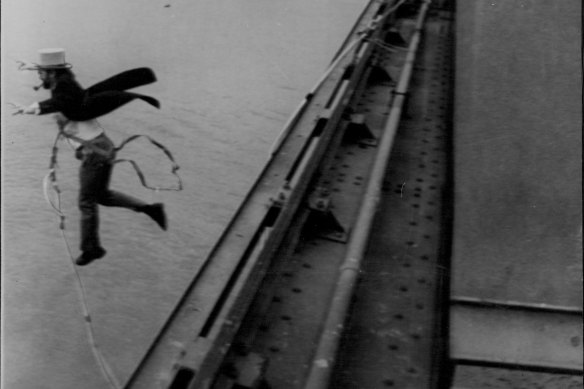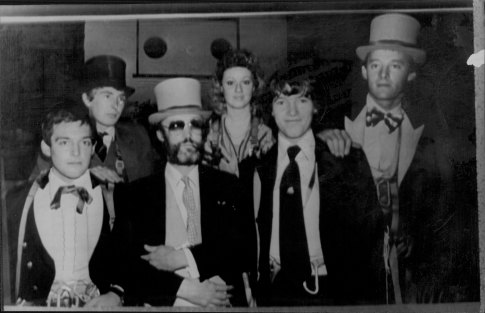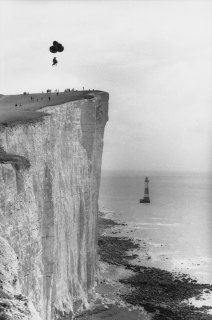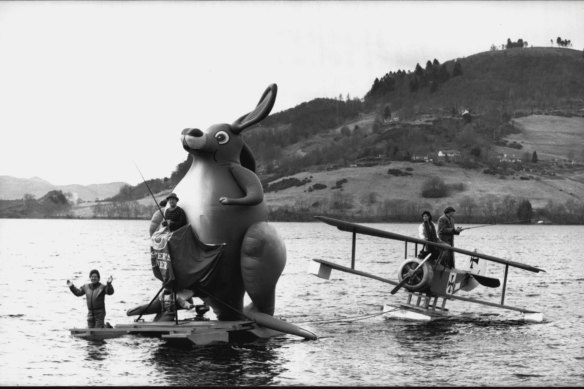This was published 6 months ago
Eccentric inventor of modern bungee jumping dies aged 78
DAVID KIRKE: 1945- 2023
David Kirke, who has died aged 78, was the guiding spirit of the Dangerous Sports Club, whose colourful exploits caused global scandal and delight in the 1980s.

Pipe clenched between his teeth, top-hatted David Kirke leaps off a ledge in 1979.Credit: Fairfax
He was best known for having invented modern bungee jumping (he always spelt it “bungy”) when early on the morning of April 1, 1979, he stepped off the parapet of the Clifton Suspension Bridge in the UK with a rope attached.
Inspired by the land-divers of Vanuatu, who vaunt their prowess by jumping from heights tied on with thick vines, the rope had not been tested. Kirke said it would hardly have been a dangerous sport if it had been. He survived and was promptly arrested.
He and his fellow jumpers were released on the understanding that they would not do it again; they went on to repeat the feat worldwide and from a variety of different structures.
Some of the glamour of the DSC derived from the fact that its members were drawn from the upper echelons of British society – at least one was the son of a marquess – and they sent themselves up by dressing up for their antics in top hats and tailcoats while clutching champagne bottles.
A consummate showman, Kirke came to relish the lavish corporate hospitality that flowed as the club gained international attention.
Numerous bizarre and white-knuckle adventures ensued. At the famed Swiss ski resort St Moritz, the DSC skied the course on, among other items, a grand piano on which a pair played a duet; a dashing white carousel horse with skis fixed to its feet, and a table and chairs complete with guests, glassware and a wine waiter. The bemused management of the Swiss resort took this all in their stride, until the arrival one year of a red London double-decker bus.
Kirke became an accidental, though not entirely reluctant, pioneer of extreme sports when some of the DSC’s pursuits actually caught on. To bungee jumping they added base jumping and microlighting, all of which now enjoy widespread popularity as organised and regulated activities. Interviewed years afterwards, Kirke said he was glad that his shenanigans had given people a bit of fun.
He was born David Anthony Potter on September 26, 1945, the eldest of seven children of Arnold Potter and Fraye St George Kirke. His mother Fraye was the scion of a distinguished military family.

Pipe-smoking David Kirke with members of the Dangerous Sports Club.Credit: Fairfax
Arnold served in World War II but was also a member of the original Cambridge Night Climbers in the 1930s, a group which scaled roofs and chapel spires at the famous college, to the chagrin of authorities.
David took after his father, getting expelled from Wellington school at 16. In due course David adopted his mother’s maiden name, to protect his immediate family from the burgeoning media circus that accompanied his mischief.
After Wellington, Kirke found love but it came to an abrupt and tragic end when his girlfriend was run over and killed by a bus, a horrific accident that Kirke witnessed. Looking back, he acknowledged that the trauma changed him. He left his job, returned to Oxford, and fell in with a crowd of eccentric and unabashedly adventurous students.

David Kirke sets in the pouch of a giant helium-filled kangaroo in 1986 attempting to cross the English Channel to France.Credit: Getty
Early DSC plans became later realities: the surreal ski runs; hang-gliding off Kilimanjaro; a tea party on Rockall, the tiny islet 230 miles off the west coast of Scotland. When Kirke piloted, from its pouch, an inflatable kangaroo held up by helium balloons across the English Channel, as an advertisement for Fosters, the ballast was beer cans. Inevitably he was prosecuted for flying without a licence.
On another occasion, he waterskied in the kangaroo across Loch Ness. He nearly died, however, when he was fired from a cannon into the Irish Sea, and, although he recovered after a lengthy spell in hospital, things began to change as wives came on the scene and began to limit their husbands’ interactions both with the DSC and with Kirke himself. He found a new audience in his nieces and nephews, to whom he was “Mad Uncle Dave”, though not always to the delight of their parents.
The advent of the internet made Kirke’s escapades easily discoverable; he was not without admirers who met him in pubs and even in church. He was frequently sloshed, always witty, unfailingly genial and constantly solicitous of the wellbeing of others. By then his ability to lose his wallet at crucial moments was prodigious.

The Dangerous Sports Club looking for the Loch Ness monster, 1986.Credit: Fairfax
His wisdom to friends was constant: from the profound to the mischievous to the unrepeatable. Among his finest was, “Always look asleep when the ticket collector comes.”
The Telegraph, London
Get a weekly wrap of views that will challenge, champion and inform your own. Sign up for our Opinion newsletter.